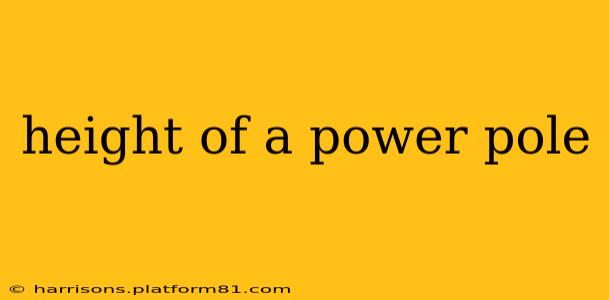Power poles, those ubiquitous structures lining our streets and countryside, come in a variety of heights depending on their purpose and location. There's no single answer to the question "What is the height of a power pole?", but this guide will delve into the factors influencing their height and offer a comprehensive overview.
What Determines the Height of a Power Pole?
Several factors influence the height of a power pole, ensuring safe and efficient electricity transmission and distribution. These key considerations include:
-
Voltage: Higher voltage power lines require taller poles to maintain adequate clearance from the ground and prevent accidental contact. This is crucial for safety and to minimize the risk of electrical outages. High-voltage transmission lines often utilize much taller structures than those carrying lower voltages for distribution.
-
Terrain: The topography of the land significantly affects pole height. In flat areas, poles might be of a standard height. However, in hilly or mountainous regions, pole height might vary considerably to maintain consistent wire clearance. Steeper inclines often necessitate taller poles on higher ground to accommodate the slope.
-
Proximity to Obstacles: The presence of trees, buildings, or other structures near the power line dictates the necessary pole height to maintain a safe distance. Taller poles are used to navigate obstacles and prevent potential hazards.
-
Local Regulations and Codes: Building codes and local regulations often stipulate minimum height requirements for power poles to ensure public safety and compliance with standards. These regulations can vary significantly depending on location and jurisdiction.
-
Type of Power Line: The type of power line—whether it's a transmission line carrying high voltage across long distances or a distribution line delivering power to homes and businesses—influences the required height. Transmission lines generally employ significantly taller poles than distribution lines.
How Tall Are Power Poles Typically?
While there's no universal standard, the height of power poles generally ranges from approximately 30 feet to well over 100 feet. Distribution poles, supplying power directly to consumers, are typically shorter, often falling within the 30- to 50-foot range. Transmission poles, carrying high-voltage electricity over long distances, can easily exceed 100 feet in height.
What are the different types of power poles?
Power poles come in various materials and designs, influencing their height and structural capabilities. Common types include:
-
Wood Poles: Traditionally prevalent, wood poles offer a cost-effective solution, although their lifespan is shorter than other materials. Their height varies based on the factors mentioned above.
-
Concrete Poles: Concrete poles provide greater strength and durability than wood, often used for higher voltage lines and in areas susceptible to harsh weather conditions. Their heights also adapt to the voltage and local conditions.
-
Steel Poles: Steel poles are known for their strength and longevity, frequently used in areas with demanding conditions or for supporting heavy loads. These poles can achieve considerable heights, especially for transmission lines.
Are there any safety concerns related to power pole height?
Maintaining adequate power pole height is paramount for public safety. Insufficient height can lead to:
-
Accidental Contact: Low-hanging wires pose a significant risk of electrocution, especially to taller vehicles or equipment.
-
Tree Interference: Trees growing too close to power lines can cause short circuits and power outages. Proper pole height minimizes this risk.
-
Damage during Storms: Strong winds and storms can damage lower poles more readily, leading to power disruptions and potential harm.
How are power pole heights determined?
The process of determining the optimal height of a power pole involves careful planning and engineering considerations. Factors such as voltage, terrain, and proximity to obstacles are analyzed to ensure safe and efficient operation. Utilities companies employ experienced engineers and utilize sophisticated software to model and determine the appropriate pole height for each specific location.
This comprehensive guide provides a thorough understanding of the height of power poles, the factors influencing this height, and the importance of maintaining adequate clearance for safety and reliability. Remember that specific heights vary greatly depending on the circumstances.
